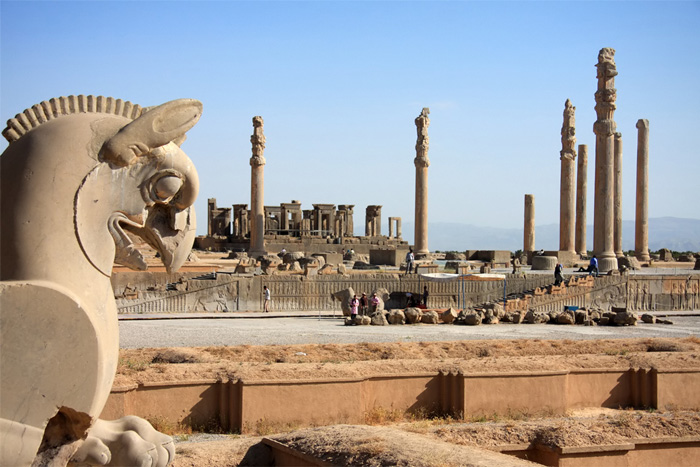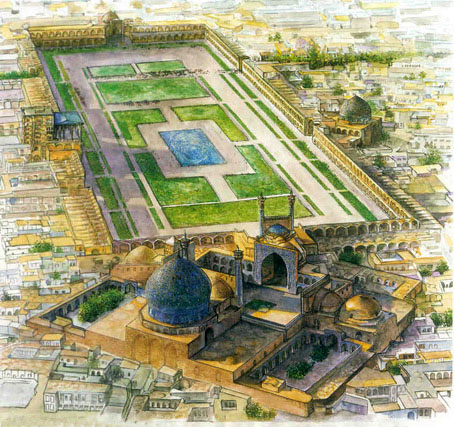Why Go to Iran?

1. World Heritage Sites in Iran:
- Chogha Zanbil, Susa (1979): The ruins of the holy city of the Kingdom of Elam centered by one of the few great Ziggurat and surrounded by three huge concentric walls. It is located on the southwest of Iran, 80 km (50 mi) north of Ahvaz.
- Persepolis, Marvdasht (1979): An ancient ceremonial capital of the second Iranian dynasty, the Achaemenid Empire. Situated central south of Iran, 70 km northeast of Shiraz city.
- Meidan Emam, Isfahan (1979):Located in the center of Isfahan city, Meidan Emam, is one of the largest city squares in the world. The square is surrounded by important historical buildings and traditional craft bazaar from the Safavid era.
- Takht-e Soleyman, Takab (2003):Takht-e Soleyman, “The Throne of Solomon”, is the holiest shrine of Zoroastrianism and the former Sassanid Empire, In northwest of Iran.
- Bam Citadel, Kerman (2004): An Achaemenid period site that is situated in a desert on the southern edge of the Iranian high plateau. Bam was almost completely destroyed in an earthquake on 2003. Since than, Rayen citadel has substituted it.
- Pasargadae, (2004): Pasargadae was a city in ancient Persia, and is today an archaeological site. The ruins lie 87 km northeast of Persepolis and was the first capital of the Persian Empire. The most important monument in Pasargadae is the tomb of Cyrus the Great.
- Soltaniyeh, Zanjan (2005): Was the capital of the Ilkhanid dynasty, which was founded by the Mongols. The main feature of Soltaniyeh’s is the Mausoleum of Il-khan Öljeitü, traditionally known as the Dome of Soltaniyeh. located some 240 kilometres (150 mi) to the north-west of Tehran.
- Bisotun, Kermanshah (2006): It contains remains dating from pre-historic times through the history of ancient Persia. located in the west of Iran, It bear’s unique testimony to the Persian Empire and the interchange of influences in art and writing in the region.
- Armenian Monastic Ensembles, Chaldoran (2008): The Armenian Monastic Ensembles of Iran, in the north-west of the country, consists of three monastic ensembles of the Armenian Christian faith. They illustrate the very long duration of relations between the Persian and Armenian civilizations.
- Historical Hydraulic System, Shushtar (2009): It is an island city from the Sassanian era with a complex irrigation system.
- Historic Bazaar Complex, Tabriz (2010): It is one of the oldest bazaars of the Middle East and the largest covered bazar in the world. Tabriz has been a city of cultural exchange since antiquity and its historic bazaar complex was one of the most important commercial centers on the Silk Road.
- Sheikh Safi al-din Khānegāh & Shrine Ensemble, Ardabil (2010): It is a Sufi spiritual retreat dating from between the early 16th century and late 18th. Ardebil is among the northwester cities of Iran.
- The Persian Garden (2011): Nine gardens through out Iranfrom different epochs and climates are registered among this category. Royal Garden of Pasargadae, Bagh-e Eram (Shiraz), Bagh-e Chehel Sotun (Isfahan), Bagh-e Fin (Kashan), Bagh-e Dolat Abad (Yazd), Bagh-e Pahlavanpur (Mehriz), Bagh-e Shahzadeh (Kerman), Bagh-e Abas Abad and Bagh-e Akbariyeh.

- Gonbad-e Qābus, Golestan (2012):It is a monumental tomb tower in the north of Iran, the earliest and tallest in this part of Asia.
- Jāmé Mosque, Isfahan (2012): Know as the encyclopedia of Iranian architecture. It displays architectural styles of different periods in the country’s Islamic architecture.
- Golestan Palace, Tehran (2013): It is a 19th century royal residence, built by the Qajar dynasty. It displays traditional Persian architecture with western influences.
- Shahr-i Sokhta or Burnt City, Zabol (2014): It is an archaeological site from the Bronze Age urban settlement. It is associated with the Jiroft culture, an “independent Bronze Age civilization with its own architecture and language”, intermediate between Elam to the west and the Indus Valley Civilization to the east.



